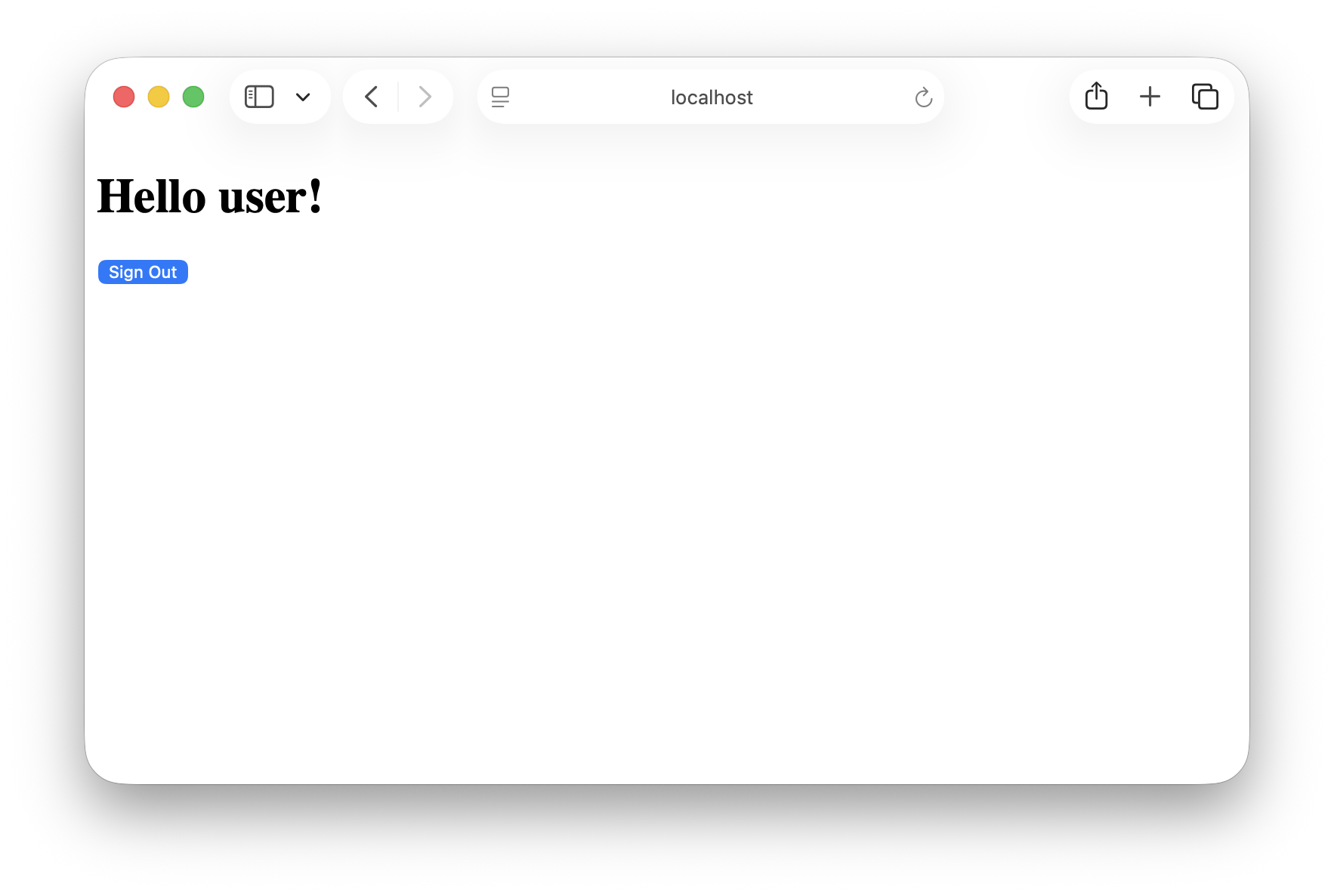# 保护Web应用程序
本指南将引导您完成使用受Spring Security保护的资源创建简单的Web应用程序的过程。
## 你会建立什么
您将构建一个Spring MVC应用程序,该应用程序使用由固定用户列表支持的登录表单来保护页面的安全。
## 你需要什么
* 约15分钟
* 最喜欢的文本编辑器或IDE
* [JDK 1.8](http://www.oracle.com/technetwork/java/javase/downloads/index.html) 或更高版本
* [Gradle 4+](http://www.gradle.org/downloads) 或 [Maven 3.2+](https://maven.apache.org/download.cgi)
* 您还可以将代码直接导入到IDE中:
* [弹簧工具套件(STS)](https://spring.io/guides/gs/sts)
* [IntelliJ IDEA](https://spring.io/guides/gs/intellij-idea/)
## 如何完成本指南
像大多数Spring 一样 [入门指南](https://spring.io/guides) ,您可以从头开始并完成每个步骤,也可以绕过您已经熟悉的基本设置步骤。 无论哪种方式,您最终都可以使用代码。
要 **从头开始** ,请继续进行“ [从Spring Initializr开始”](https://spring.io/guides/gs/securing-web/#scratch) 。
要 **跳过基础知识** ,请执行以下操作:
* [下载](https://github.com/spring-guides/gs-securing-web/archive/master.zip) 并解压缩本指南的源存储库,或使用 对其进行克隆 [Git](https://spring.io/understanding/Git) : `git clone [https://github.com/spring-guides/gs-securing-web.git](https://github.com/spring-guides/gs-securing-web.git)`
* 光盘进入 `gs-securing-web/initial`
* 继续 [创建一个不安全的Web应用程序](https://spring.io/guides/gs/securing-web/#initial) 。
**完成后** ,您可以根据中的代码检查结果 `gs-securing-web/complete`.
## 从Spring Initializr开始
如果您使用Maven,请访问 [Spring Initializr](https://start.spring.io/#!type=maven-project&language=java&platformVersion=2.4.3.RELEASE&packaging=jar&jvmVersion=1.8&groupId=com.example&artifactId=securing-web&name=securing-web&description=Demo%20project%20for%20Spring%20Boot&packageName=com.example.securing-web&dependencies=web,thymeleaf) 以生成具有所需依赖项(Spring Web和Thymeleaf)的新项目。
以下清单显示了 `pom.xml` 选择Maven时创建的文件:
~~~
<?xml version="1.0" encoding="UTF-8"?>
<project xmlns="http://maven.apache.org/POM/4.0.0" xmlns:xsi="http://www.w3.org/2001/XMLSchema-instance"
xsi:schemaLocation="http://maven.apache.org/POM/4.0.0 https://maven.apache.org/xsd/maven-4.0.0.xsd">
<modelVersion>4.0.0</modelVersion>
<parent>
<groupId>org.springframework.boot</groupId>
<artifactId>spring-boot-starter-parent</artifactId>
<version>2.4.3</version>
<relativePath/> <!-- lookup parent from repository -->
</parent>
<groupId>com.example</groupId>
<artifactId>securing-web</artifactId>
<version>0.0.1-SNAPSHOT</version>
<name>securing-web</name>
<description>Demo project for Spring Boot</description>
<properties>
<java.version>1.8</java.version>
</properties>
<dependencies>
<dependency>
<groupId>org.springframework.boot</groupId>
<artifactId>spring-boot-starter-thymeleaf</artifactId>
</dependency>
<dependency>
<groupId>org.springframework.boot</groupId>
<artifactId>spring-boot-starter-web</artifactId>
</dependency>
<dependency>
<groupId>org.springframework.boot</groupId>
<artifactId>spring-boot-starter-test</artifactId>
<scope>test</scope>
</dependency>
</dependencies>
<build>
<plugins>
<plugin>
<groupId>org.springframework.boot</groupId>
<artifactId>spring-boot-maven-plugin</artifactId>
</plugin>
</plugins>
</build>
</project>
~~~
如果您使用Gradle,请访问 [Spring Initializr](https://start.spring.io/#!type=gradle-project&language=java&platformVersion=2.4.3.RELEASE&packaging=jar&jvmVersion=1.8&groupId=com.example&artifactId=securing-web&name=securing-web&description=Demo%20project%20for%20Spring%20Boot&packageName=com.example.securing-web&dependencies=web,thymeleaf) 以生成具有所需依赖项(Spring Web和Thymeleaf)的新项目。
以下清单显示了 `build.gradle` 选择Gradle时创建的文件:
~~~
plugins {
id 'org.springframework.boot' version '2.4.3'
id 'io.spring.dependency-management' version '1.0.11.RELEASE'
id 'java'
}
group = 'com.example'
version = '0.0.1-SNAPSHOT'
sourceCompatibility = '1.8'
repositories {
mavenCentral()
}
dependencies {
implementation 'org.springframework.boot:spring-boot-starter-thymeleaf'
implementation 'org.springframework.boot:spring-boot-starter-web'
testImplementation('org.springframework.boot:spring-boot-starter-test')
}
test {
useJUnitPlatform()
}
~~~
### 手动初始化(可选)
如果要手动初始化项目而不是使用前面显示的链接,请按照以下步骤操作:
1. 导航到 [https://start.spring.io](https://start.spring.io) 。 该服务提取应用程序所需的所有依赖关系,并为您完成大部分设置。
2. 选择Gradle或Maven以及您要使用的语言。 本指南假定您选择了Java。
3. 单击 **Dependencies,** 然后选择 **Spring Web** 和 **Thymeleaf** 。
4. 点击 **生成** 。
5. 下载生成的ZIP文件,该文件是使用您的选择配置的Web应用程序的存档。
如果您的IDE集成了Spring Initializr,则可以从IDE中完成此过程。
## 创建一个不安全的Web应用程序
在将安全性应用于Web应用程序之前,需要Web应用程序进行安全保护。 本节将引导您创建一个简单的Web应用程序。 然后,您将在下一部分中使用Spring Security对其进行保护。
该Web应用程序包括两个简单的视图:主页和“ Hello,World”页面。 主页在以下Thymeleaf模板中定义(来自 `src/main/resources/templates/home.html`):
~~~
<!DOCTYPE html>
<html xmlns="http://www.w3.org/1999/xhtml" xmlns:th="https://www.thymeleaf.org" xmlns:sec="https://www.thymeleaf.org/thymeleaf-extras-springsecurity3">
<head>
<title>Spring Security Example</title>
</head>
<body>
<h1>Welcome!</h1>
<p>Click <a th:href="@{/hello}">here</a> to see a greeting.</p>
</body>
</html>
~~~
这个简单的视图包含一个指向 `/hello` 页面,该页面在以下Thymeleaf模板中定义(来自 `src/main/resources/templates/hello.html`):
~~~
<!DOCTYPE html>
<html xmlns="http://www.w3.org/1999/xhtml" xmlns:th="https://www.thymeleaf.org"
xmlns:sec="https://www.thymeleaf.org/thymeleaf-extras-springsecurity3">
<head>
<title>Hello World!</title>
</head>
<body>
<h1>Hello world!</h1>
</body>
</html>
~~~
该Web应用程序基于Spring MVC。 因此,您需要配置Spring MVC并设置视图控制器以公开这些模板。 以下清单(来自 `src/main/java/com/example/securingweb/MvcConfig.java`)显示了一个在应用程序中配置Spring MVC的类:
~~~
package com.example.securingweb;
import org.springframework.context.annotation.Configuration;
import org.springframework.web.servlet.config.annotation.ViewControllerRegistry;
import org.springframework.web.servlet.config.annotation.WebMvcConfigurer;
@Configuration
public class MvcConfig implements WebMvcConfigurer {
public void addViewControllers(ViewControllerRegistry registry) {
registry.addViewController("/home").setViewName("home");
registry.addViewController("/").setViewName("home");
registry.addViewController("/hello").setViewName("hello");
registry.addViewController("/login").setViewName("login");
}
}
~~~
这 `addViewControllers()` 方法(该方法将覆盖其中相同名称的方法 `WebMvcConfigurer`)添加了四个视图控制器。 两个视图控制器引用名称为 `home` (在 `home.html`),另一个引用了名为的视图 `hello` (在 `hello.html`)。 第四个视图控制器引用另一个名为 `login`。 您将在下一部分中创建该视图。
此时,您可以跳至“ [Run the Application](https://spring.io/guides/gs/securing-web/#run_the_app) ”并运行应用程序,而无需登录任何内容。
既然您拥有一个不安全的Web应用程序,则可以为其添加安全性。
## 设置Spring Security
假设您要防止未经授权的用户查看位于的问候页面 `/hello`。 现在,如果访问者单击主页上的链接,他们将看到问候,没有任何障碍可以阻止他们。 您需要添加一个屏障,以迫使访问者登录才能看到该页面。
您可以通过在应用程序中配置Spring Security来实现。 如果Spring Security在类路径中,则Spring Boot会 [自动保护所有HTTP端点](https://docs.spring.io/spring-boot/docs/2.4.3/reference/htmlsingle/#boot-features-security) 使用“基本”身份验证 。 但是,您可以进一步自定义安全设置。 您需要做的第一件事是将Spring Security添加到类路径中。
使用Gradle,您需要在代码行中添加两行(一行用于应用程序,另一行用于测试)。 `dependencies` 封闭在 `build.gradle`,如以下清单所示:
~~~
implementation 'org.springframework.boot:spring-boot-starter-security'
implementation 'org.springframework.security:spring-security-test'
~~~
以下清单显示了成品 `build.gradle` 文件:
~~~
plugins {
id 'org.springframework.boot' version '2.4.3'
id 'io.spring.dependency-management' version '1.0.11.RELEASE'
id 'java'
}
group = 'com.example'
version = '0.0.1-SNAPSHOT'
sourceCompatibility = '1.8'
repositories {
mavenCentral()
}
dependencies {
implementation 'org.springframework.boot:spring-boot-starter-thymeleaf'
implementation 'org.springframework.boot:spring-boot-starter-web'
implementation 'org.springframework.boot:spring-boot-starter-security'
implementation 'org.springframework.security:spring-security-test'
testImplementation('org.springframework.boot:spring-boot-starter-test')
}
test {
useJUnitPlatform()
}
~~~
使用Maven,您需要将两个额外的条目(一个用于应用程序,一个用于测试)添加到 `<dependencies>` 元素在 `pom.xml`,如以下清单所示:
~~~
<dependency>
<groupId>org.springframework.boot</groupId>
<artifactId>spring-boot-starter-security</artifactId>
</dependency>
<dependency>
<groupId>org.springframework.security</groupId>
<artifactId>spring-security-test</artifactId>
<scope>test</scope>
</dependency>
~~~
以下清单显示了成品 `pom.xml` 文件:
~~~
<?xml version="1.0" encoding="UTF-8"?>
<project xmlns="http://maven.apache.org/POM/4.0.0" xmlns:xsi="http://www.w3.org/2001/XMLSchema-instance"
xsi:schemaLocation="http://maven.apache.org/POM/4.0.0 https://maven.apache.org/xsd/maven-4.0.0.xsd">
<modelVersion>4.0.0</modelVersion>
<parent>
<groupId>org.springframework.boot</groupId>
<artifactId>spring-boot-starter-parent</artifactId>
<version>2.4.3</version>
<relativePath/> <!-- lookup parent from repository -->
</parent>
<groupId>com.example</groupId>
<artifactId>securing-web</artifactId>
<version>0.0.1-SNAPSHOT</version>
<name>securing-web</name>
<description>Demo project for Spring Boot</description>
<properties>
<java.version>1.8</java.version>
</properties>
<dependencies>
<dependency>
<groupId>org.springframework.boot</groupId>
<artifactId>spring-boot-starter-thymeleaf</artifactId>
</dependency>
<dependency>
<groupId>org.springframework.boot</groupId>
<artifactId>spring-boot-starter-web</artifactId>
</dependency>
<dependency>
<groupId>org.springframework.boot</groupId>
<artifactId>spring-boot-starter-security</artifactId>
</dependency>
<dependency>
<groupId>org.springframework.security</groupId>
<artifactId>spring-security-test</artifactId>
<scope>test</scope>
</dependency>
<dependency>
<groupId>org.springframework.boot</groupId>
<artifactId>spring-boot-starter-test</artifactId>
<scope>test</scope>
</dependency>
</dependencies>
<build>
<plugins>
<plugin>
<groupId>org.springframework.boot</groupId>
<artifactId>spring-boot-maven-plugin</artifactId>
</plugin>
</plugins>
</build>
</project>
~~~
以下安全配置(来自 `src/main/java/com/example/securingweb/WebSecurityConfig.java`)确保只有经过身份验证的用户才能看到秘密问候:
~~~
package com.example.securingweb;
import org.springframework.context.annotation.Bean;
import org.springframework.context.annotation.Configuration;
import org.springframework.security.config.annotation.web.builders.HttpSecurity;
import org.springframework.security.config.annotation.web.configuration.EnableWebSecurity;
import org.springframework.security.config.annotation.web.configuration.WebSecurityConfigurerAdapter;
import org.springframework.security.core.userdetails.User;
import org.springframework.security.core.userdetails.UserDetails;
import org.springframework.security.core.userdetails.UserDetailsService;
import org.springframework.security.provisioning.InMemoryUserDetailsManager;
@Configuration
@EnableWebSecurity
public class WebSecurityConfig extends WebSecurityConfigurerAdapter {
@Override
protected void configure(HttpSecurity http) throws Exception {
http
.authorizeRequests()
.antMatchers("/", "/home").permitAll()
.anyRequest().authenticated()
.and()
.formLogin()
.loginPage("/login")
.permitAll()
.and()
.logout()
.permitAll();
}
@Bean
@Override
public UserDetailsService userDetailsService() {
UserDetails user =
User.withDefaultPasswordEncoder()
.username("user")
.password("password")
.roles("USER")
.build();
return new InMemoryUserDetailsManager(user);
}
}
~~~
这 `WebSecurityConfig` 该类带有注释 `@EnableWebSecurity`启用Spring Security的Web安全支持并提供Spring MVC集成。 它也延伸 `WebSecurityConfigurerAdapter` 并覆盖了它的几种方法来设置网络安全配置的某些细节。
这 `configure(HttpSecurity)`方法定义应该保护哪些URL路径,哪些不应该保护。 具体来说, `/` 和 `/home`路径配置为不需要任何身份验证。 所有其他路径必须经过验证。
用户成功登录后,他们将被重定向到先前要求的页面,该页面需要身份验证。 有一个习惯 `/login` 页面(由 `loginPage()`),每个人都可以查看。
这 `userDetailsService()`方法用一个用户建立一个内存用户存储。 该用户的用户名为 `user`,密码为 `password`,以及 `USER`.
现在,您需要创建登录页面。 已经有一个视图控制器 `login` 视图,因此您只需要创建登录视图本身,如下面的清单(来自 `src/main/resources/templates/login.html`)显示:
~~~
<!DOCTYPE html>
<html xmlns="http://www.w3.org/1999/xhtml" xmlns:th="https://www.thymeleaf.org"
xmlns:sec="https://www.thymeleaf.org/thymeleaf-extras-springsecurity3">
<head>
<title>Spring Security Example </title>
</head>
<body>
<div th:if="${param.error}">
Invalid username and password.
</div>
<div th:if="${param.logout}">
You have been logged out.
</div>
<form th:action="@{/login}" method="post">
<div><label> User Name : <input type="text" name="username"/> </label></div>
<div><label> Password: <input type="password" name="password"/> </label></div>
<div><input type="submit" value="Sign In"/></div>
</form>
</body>
</html>
~~~
此Thymeleaf模板提供了一种表单,可捕获用户名和密码并将其发布到 `/login`。 根据配置,Spring Security提供了一个过滤器,该过滤器拦截该请求并验证用户身份。 如果用户认证失败,则页面被重定向到 `/login?error`,然后页面会显示相应的错误消息。 成功注销后,您的申请将发送到 `/login?logout`,然后页面会显示相应的成功消息。
最后,您需要为访问者提供一种显示当前用户名并注销的方法。 为此,请更新 `hello.html` 向当前用户问好并包含一个 `Sign Out`形式,如下清单(来自 `src/main/resources/templates/hello.html`)显示:
~~~
<!DOCTYPE html>
<html xmlns="http://www.w3.org/1999/xhtml" xmlns:th="https://www.thymeleaf.org"
xmlns:sec="https://www.thymeleaf.org/thymeleaf-extras-springsecurity3">
<head>
<title>Hello World!</title>
</head>
<body>
<h1 th:inline="text">Hello [[${#httpServletRequest.remoteUser}]]!</h1>
<form th:action="@{/logout}" method="post">
<input type="submit" value="Sign Out"/>
</form>
</body>
</html>
~~~
我们通过使用Spring Security的集成来显示用户名 `HttpServletRequest#getRemoteUser()`。 “登出”表单将POST提交到 `/logout`。 成功注销后,它将用户重定向到 `/login?logout`.
## 运行应用程序
Spring Initializr为您创建一个应用程序类。 在这种情况下,您无需修改类。 以下清单(来自 `src/main/java/com/example/securingweb/SecuringWebApplication.java`)显示了应用程序类:
~~~
package com.example.securingweb;
import org.springframework.boot.SpringApplication;
import org.springframework.boot.autoconfigure.SpringBootApplication;
@SpringBootApplication
public class SecuringWebApplication {
public static void main(String[] args) throws Throwable {
SpringApplication.run(SecuringWebApplication.class, args);
}
}
~~~
### 建立可执行的JAR
您可以使用Gradle或Maven从命令行运行该应用程序。 您还可以构建一个包含所有必需的依赖项,类和资源的可执行JAR文件,然后运行该文件。 生成可执行jar使得在整个开发生命周期中,跨不同环境等等的情况下,都可以轻松地将服务作为应用程序进行发布,版本控制和部署。
如果您使用Gradle,则可以通过使用以下命令运行该应用程序 `./gradlew bootRun`。 或者,您可以通过使用以下命令构建JAR文件: `./gradlew build` 然后运行JAR文件,如下所示:
~~~
java -jar build/libs/gs-securing-web-0.1.0.jar
~~~
如果您使用Maven,则可以通过使用以下命令运行该应用程序 `./mvnw spring-boot:run`。 或者,您可以使用以下命令构建JAR文件: `./mvnw clean package` 然后运行JAR文件,如下所示:
~~~
java -jar target/gs-securing-web-0.1.0.jar
~~~
此处描述的步骤将创建可运行的JAR。 您还可以 构建经典的WAR文件 。
应用程序启动后,将浏览器指向 `[http://localhost:8080](http://localhost:8080)`。 您应该看到主页,如下图所示:

当您单击链接时,它会尝试将您带到以下位置的问候页面 `/hello`。 但是,由于该页面是安全的,并且您尚未登录,因此将您带到登录页面,如下图所示:

如果您使用不安全的版本跳到此处,则看不到登录页面。 您应该备份并编写其余基于安全性的代码。
在登录页面上,输入以下内容以测试用户身份登录 `user` 和 `password`分别用于用户名和密码字段。 提交登录表单后,将对您进行身份验证,然后转到问候页面,如下图所示:

如果单击“ **退出”** 按钮,则您的身份验证将被撤消,并且将返回到登录页面,并显示一条消息,指示您已注销。
## 概括
恭喜你! 您已经开发了一个受Spring Security保护的简单Web应用程序。
- springboot概述
- springboot构建restful服务
- spring构建一个RESTful Web服务
- spring定时任务
- 消费RESTful Web服务
- gradle构建项目
- maven构建项目
- springboot使用jdbc
- springboot应用上传文件
- 使用LDNA验证用户
- 使用 spring data redis
- 使用 spring RabbitTemplate消息队列
- 用no4j访问nosql数据库
- springboot验证web表单
- Spring Boot Actuator构j建服务
- 使用jms传递消息
- springboot创建批处理服务
- spring security保护web 安全
- 在Pivotal GemFire中访问数据
- 使用Spring Integration
- 使用springboot jpa进行数据库操作
- 数据库事务操作
- 操作mongodb
- springmvc+tymleaf创建web应用
- 将Spring Boot JAR应用程序转换为WAR
- 创建异步服务
- spring提交表单
- 使用WebSocket构建交互式Web应用程序
- 使用REST访问Neo4j数据
- jquery消费restful
- springboot跨域请求
- 消费SOAP Web服务
- springboot使用缓存
- 使用Vaadin创建CRUD UI
- 使用REST访问JPA数据
- 使用REST访问Pivotal GemFire中的数据
- 构建soap服务
- 使用rest访问mongodb数据
- 构建springboot应用docker镜像
- 从STS部署到Cloud Foundry
- springboot测试web应用
- springboot访问mysql
- springboot编写自定义模块并使用
- 使用Google Cloud Pub / Sub进行消息传递
- 构建反应式RESTful Web服务
- 使用Redis主动访问数据
- Spring Boot 部署到Kubernetes
- 使用反应式协议R2DBC访问数据
- Spring Security架构
- spring构建Docker镜像详解
- Spring Boot和OAuth2
- springboot应用部署到k8s
- spring构建rest服务详解
